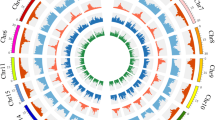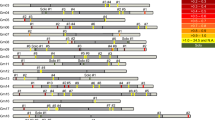Abstract
Modern sugarcane cultivars are highly polyploid and derived from the hybridization of Saccharum officinarum and S. spontaneum, thus leading to singularly complex genomes. The complex genome has hindered the study of genomic structures. Here, we adopted a computational strategy to isolate highly repetitive and abundant sequences in either S. officinarum or S. spontaneum and isolated four S. spontaneum-enriched retrotransposons. Fluorescence in situ hybridization (FISH) assays with these repetitive DNA sequences generated whole-genome painting signals for S. spontaneum but not for S. officinarum. We demonstrated that these repetitive sequence-based probes distinguish the parental S. spontaneum genome in hybrids derived from crosses between it and S. officinarum. A cytological analysis of 14 modern sugarcane cultivars revealed that the percentages of chromosomes with introgressive S. spontaneum fragments ranged from 11.9 to 40.9% and substantially exceeded those determined for previously investigated cultivars (5–13%). The comparatively higher percentages of introgressive S. spontaneum fragments detected in the aforementioned cultivars indicate frequent recombination between parental genomes. Here, we present the application of our strategy to isolate species-specific cytological markers. This information may help to elucidate complex plant genomic structures and trace their evolutionary histories.






Similar content being viewed by others
References
Albert PS, Zhang T, Semrau K, Rouillard JM, Kao YH, Wang CR, Danilova TV, Jiang J, Birchler JA (2019) Whole-chromosome paints in maize reveal rearrangements, nuclear domains, and chromosomal relationships. Proc Natl Acad Sci U S A 116:1679–1685
Bolger AM, Lohse M, Usadel B (2014) Trimmomatic: a flexible trimmer for Illumina sequence data. Bioinformatics 30:2114–2120
Bremer G (1923) A cytological investigation of some species and species hybrids within the genus Saccharum. Genetica 5:97–148
Cuadrado A, Acevedo R, Moreno Díaz de la Espina S, Jouve N, de la Torre C (2004) Genome remodelling in three modern S. officinarum × S. spontaneum sugarcane cultivars. J Exp Bot 55:847–854
Daniels J, Roach BT (1987) Taxonomy and evolution. In: Heinz DJ (ed) Sugarcane improvement through breeding. Elsevier, Amsterdam, pp 7–84
D'Hont A (2005) Unraveling the genome structure of polyploids using FISH and GISH; examples of sugarcane and banana. Cytogenet Genome Res 109:27–33
D'Hont A, Lu YH, Feldmann P, Glaszmann JC (1993) Cytoplasmic diversity in sugar cane revealed by heterologous probes. Sugar Cane 1:12–25
D'Hont A, Rao PS, Feldmann P, Grivet L, Islam-Faridi N, Taylor P, Glaszmann JC (1995) Identification and characterisation of sugarcane intergeneric hybrids, Saccharum officinarum x Erianthus arundinaceus, with molecular markers and DNA in situ hybridisation. Theor Appl Genet 91:320–326
D'Hont A, Grivet L, Feldmann P, Glaszmann JC, Rao S, Berding N (1996) Characterisation of the double genome structure of modern sugarcane cultivars (Saccharum spp.) by molecular cytogenetics. Mol Gen Genomics 250:405–413
D'Hont A, Paulet F, Glaszmann JC (2002) Oligoclonal interspecific origin of ‘north Indian’ and ‘Chinese’ sugarcanes. Chromosom Res 10:253–262
Garsmeur O, Droc G, Antonise R, Grimwood J, Potier B, Aitken K, Jenkins J, Martin G, Charron C, Hervouet C, Costet L, Yahiaoui N, Healey A, Sims D, Cherukuri Y, Sreedasyam A, Kilian A, Chan A, Van Sluys MA, Swaminathan K, Town C, Berges H, Simmons B, Glaszmann JC, van der Vossen E, Henry R, Schmutz J, D'Hont A (2018) A mosaic monoploid reference sequence for the highly complex genome of sugarcane. Nat Commun 9:2638
Guimaraes CT, Sills GR, Sobral BW (1997) Comparative mapping of Andropogoneae: Saccharum L. (sugarcane) and its relation to sorghum and maize. Proc Natl Acad Sci U S A 94:14261–14266
Han Y, Zhang T, Thammapichai P, Weng Y, Jiang J (2015) Chromosome-specific painting in cucumis species using bulked oligonucleotides. Genetics 200:771–779
Han J, Masonbrink RE, Shan W, Song F, Zhang J, Yu W, Wang K, Wu Y, Tang H, Wendel JF, Wang K (2016) Rapid proliferation and nucleolar organizer targeting centromeric retrotransposons in cotton. Plant J 88:992–1005
Irvine JE (1999) Saccharum species as horticultural classes. Theor Appl Genet 98:186–194
Jannoo N, Grivet L, Seguin M, Paulet F, Domaingue R, Rao PS, Dookun A, D'Hont A, Glaszmann JC (1999) Molecular investigation of the genetic base of sugarcane cultivars. Theor Appl Genet 99:171–184
Jiang J, Gill BS (2006) Current status and the future of fluorescence in situ hybridization (FISH) in plant genome research. Genome 49:1057–1068
Koo D-H, Jiang J (2009) Super-stretched pachytene chromosomes for fluorescence in situ hybridization mapping and immunodetection of DNA methylation. Plant J 59:509–516
Lennoux CG (1939) Sugarcane collection in New Guinea during 1937. Proc Int Soc Sugar Cane Technol 6:171–182
Li Y, Zuo S, Zhang Z, Li Z, Han J, Chu Z, Hasterok R, Wang K (2018) Centromeric DNA characterization in the model grass Brachypodium distachyon provides insights on the evolution of the genus. Plant J 93:1088–1101
Lu YH, D'Hont A, Walker DIT, Rao PS, Feldmann P, Glaszmann JC (1994) Relationships among ancestral species of sugarcane revealed with RFLP using single copy maize nuclear probes. Euphytica 78:7–18
Marin I, Llorens C (2000) Ty3/gypsy retrotransposons: description of new Arabidopsis thaliana elements and evolutionary perspectives derived from comparative genomic data. Mol Biol Evol 17:1040–1049
Meng Z, Zhang Z, Yan T, Lin Q, Wang Y, Huang W, Huang Y, Li Z, Yu Q, Wang J, Wang K (2018) Comprehensively characterizing the cytological features of Saccharum spontaneum by the development of a complete set of chromosome-specific oligo probes. Front Plant Sci 9:1624
Ming R, Moore PH, Wu K-K, D'Hont A, Glaszmann JC, Tew TL, Mirkov TE, da Silva J, Jifon J, Rai M, Schnell RJ, Brumbley SM, Lakshmanan P, Comstock JC, Paterson AH (2010) Sugarcane improvement through breeding and biotechnology. Plant breeding reviews. Wiley, Hoboken, pp 15–118
Novak P, Neumann P, Pech J, Steinhaisl J, Macas J (2013) RepeatExplorer: a galaxy-based web server for genome-wide characterization of eukaryotic repetitive elements from next-generation sequence reads. Bioinformatics 29:792–793
Piperidis G, D'Hont A, Hogarth DM (2001) Chromosome composition analysis of various Saccharum interspecific hybrids by genomic in situ hybridisation (GISH). International Society of Sugar Cane Technologists Proceedings of the XXIV Congress, Brisbane, Australia, 17-21 September 2001 volume 2. pp 565-566
Piperidis G, Piperidis N, D'Hont A (2010) Molecular cytogenetic investigation of chromosome composition and transmission in sugarcane. Mol Gen Genomics 284:65–73
Schenck S, Crepeau MW, Wu KK, Moore PH, Yu Q, Ming R (2004) Genetic diversity and relationships in native Hawaiian Saccharum officinarum sugarcane. J Hered 95:327–331
Telesnitsky A, Goff SP (1997) Reverse transcriptase and the generation of retroviral DNA. In: Coffin JM, Hughes SH, Varmus HE (eds) Retroviruses. Cold Spring Harbor Laboratory Press, Cold Spring Harbor (NY)
Treangen TJ, Salzberg SL (2012) Repetitive DNA and next-generation sequencing: computational challenges and solutions. Nat Rev Genet 13:36–46
Wang K, Guo W, Zhang T (2007) Development of one set of chromosome-specific microsatellite-containing BACs and their physical mapping in Gossypium hirsutum L. Theor Appl Genet 115:675–682
Wang K, Yang Z, Shu C, Hu J, Lin Q, Zhang W, Guo W, Zhang T (2009) Higher axial-resolution and sensitivity pachytene fluorescence in situ hybridization protocol in tetraploid cotton. Chromosom Res 17:1041–1050
Wicker T, Gundlach H, Spannagl M, Uauy C, Borrill P, Ramirez-Gonzalez RH, De Oliveira R, International Wheat Genome Sequencing C, KFX M, Paux E, Choulet F (2018) Impact of transposable elements on genome structure and evolution in bread wheat. Genome Biol 19:103
Xu Z, Wang H (2007) LTR_FINDER: an efficient tool for the prediction of full-length LTR retrotransposons. Nucleic Acids Res 35:W265–W268
Yang X, Song J, Todd J, Peng Z, Paudel D, Luo Z, Ma X, You Q, Hanson E, Zhao Z, Zhao Y, Zhang J, Ming R, Wang J (2019) Target enrichment sequencing of 307 germplasm accessions identified ancestry of ancient and modern hybrids and signatures of adaptation and selection in sugarcane (Saccharum spp.), a ‘sweet’ crop with ‘bitter’ genomes. Plant Biotechnol J 17:488–498
Zhang W, Zuo S, Li Z, Meng Z, Han J, Song J, Pan YB, Wang K (2017) Isolation and characterization of centromeric repetitive DNA sequences in Saccharum spontaneum. Sci Rep 7:41659
Zhang J, Zhang X, Tang H, Zhang Q, Hua X, Ma X, Zhu F, Jones T, Zhu X, Bowers J, Wai CM, Zheng C, Shi Y, Chen S, Xu X, Yue J, Nelson DR, Huang L, Li Z, Xu H, Zhou D, Wang Y, Hu W, Lin J, Deng Y, Pandey N, Mancini M, Zerpa D, Nguyen JK, Wang L, Yu L, Xin Y, Ge L, Arro J, Han JO, Chakrabarty S, Pushko M, Zhang W, Ma Y, Ma P, Lv M, Chen F, Zheng G, Xu J, Yang Z, Deng F, Chen X, Liao Z, Zhang X, Lin Z, Lin H, Yan H, Kuang Z, Zhong W, Liang P, Wang G, Yuan Y, Shi J, Hou J, Lin J, Jin J, Cao P, Shen Q, Jiang Q, Zhou P, Ma Y, Zhang X, Xu R, Liu J, Zhou Y, Jia H, Ma Q, Qi R, Zhang Z, Fang J, Fang H, Song J, Wang M, Dong G, Wang G, Chen Z, Ma T, Liu H, Dhungana SR, Huss SE, Yang X, Sharma A, Trujillo JH, Martinez MC, Hudson M, Riascos JJ, Schuler M, Chen LQ, Braun DM, Li L, Yu Q, Wang J, Wang K, Schatz MC, Heckerman D, Van Sluys MA, Souza GM, Moore PH, Sankoff D, VanBuren R, Paterson AH, Nagai C, Ming R (2018) Allele-defined genome of the autopolyploid sugarcane Saccharum spontaneum L. Nat Genet 50:1565–1573
Zhang J, Zhang Q, Li L, Tang H, Zhang Q, Chen Y, Arrow J, Zhang X, Wang A, Miao C, Ming R (2019) Recent polyploidization events in three Saccharum founding species. Plant Biotechnol J 17:264–274
Funding
This research was supported by the National Natural Science Foundation of China (31771862) and International cooperation project of Fujian Agriculture and Forestry University (KXGH17002).
Author information
Authors and Affiliations
Contributions
KW and ZW acquired financial support and provided overall direction of the project. KW, ZW, and YH designed the research. YH, HC, SM, and GY performed the experiments. JH and YZ conducted the bioinformatic analysis. KW, ZW, and YH analyzed the data and wrote the manuscript.
Corresponding authors
Ethics declarations
The authors declare that this paper complies with all relevant ethical standards.
Competing interests
The authors declare that they have no competing interests.
Additional information
Publisher’s note
Springer Nature remains neutral with regard to jurisdictional claims in published maps and institutional affiliations.
Rights and permissions
About this article
Cite this article
Huang, Y., Chen, H., Han, J. et al. Species-specific abundant retrotransposons elucidate the genomic composition of modern sugarcane cultivars. Chromosoma 129, 45–55 (2020). https://doi.org/10.1007/s00412-019-00729-1
Received:
Revised:
Accepted:
Published:
Issue Date:
DOI: https://doi.org/10.1007/s00412-019-00729-1




